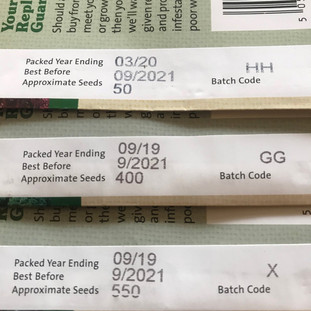Grow your own - Dig for Victory - Kale
- Mar 19, 2020
- 4 min read
Last time we spoke about how we might grow our own veg. We thought we'd start with kale. Why kale?
Well:
It's tasty.
It's nutritious - a rich source of iron and vitamins A, C & E.
It's easy to grow - either in a veg plot or in a flower border.
Last year you might have read about our cruciferous veg - if you missed that you can read it here: https://www.trugandlettuce.co.uk/post/time-to-grow
Those seeds enjoyed a trip to the Lake District at Easter so we could water and nurture them. However the seeds we're about to sow aren't going anywhere! This article is simply about how easy they are to grow, and how you can grow them.

Here's that old book again and in good old fashioned Blue Peter style some we grew earlier! We used the seed that was left over from last year and you can see how some have germinated really well and others haven't. It was the redbor variety that have done well - we'll explain why that might be later. You can see that they've grown towards the light and are slightly leggy.
We can address that but as only one of the varieties has germinated as well as we needed it to we thought we'd sow some more. This is what we need:
Something to sow our seeds in. You can use anything from a seed tray to individual pots. We saw these Windowsill Greenhouses the other day in Aldi - they come with a clear cover that provides ideal germinating conditions, sit on a windowsill to give some warmth and light and cost less than £2. Equally you could do the same with a pot that you can put in a clear plastic bag until the seeds have germinated.
We also need a growing medium. There are loads to choose from. We bought this one from Lidl. Again less than £2. Ok it's not what we might always use as it's peat based but for the sake of expediency that's what we've gone with.
And finally we need our seeds. Bought online from Marshalls and with free P&P the lot cost us £6. Ok that might seem like a lot on seeds - and look how many you actually get - but have a look at that article and see what we did with our surplus seeds last year - we sold them and donated all funds raised to a local Frome based charity.
Check the date on the seeds and as long as they're in date then crack on...….
The first thing we need to do is open the seed packet. Carefully. Some seeds come in a foil envelope that contains the seeds and keeps them fresh - that was, we suspect the reason that the seeds we sowed earlier in the month didn't germinate as well as the others. Some seeds don't come in a foil envelope and come loose in the actual packet. And if you don't open it carefully they go all over the place...…..
You'll see that the seeds don't look like you might expect. That's because invariably seeds that come from the main suppliers are coated in a magic coating that - the seed suppliers tell us - gives them a better chance of not rotting and actually germinating.
In our case we used a pencil to make a slight planting hole about 1cm deep. We then popped a number of seeds into each hole and gently firmed that up.
Finally we lightly watered them in using a normal sprayer, labelled them so we know what's what when they come up and placed the cover on. Then we took them to somewhere suitable so they could "do their thing" without interruption from little fingers or paws.....

See? A windowsill greenhouse sat on a windowsill. Ok so the windowsill could have done with a dust. And there's flicks of emulsion on it. And the double glazed units are slightly blown. But we can't see the seeds complaining!
So what do we need to do next? Well just keep an eye on them for now. They might need a light spray of water if the compost dries out - as it probably will - but in between 7 & 14 days we ought to see the seedlings emerge. We'll talk then about what we need to do next.
For now start thinking about their final home.
They aren't that fussy and will tolerate a little shade and are completely frost hardy. They aren't particularly vulnerable to pests - although the pigeons at the allotment will devour them in days (!) - and they can be grown in most soils. Like all plants, they'll benefit from some organic matter being added to the soil when the time comes to plant them out.
What we're going to do next is find a suitable place to plant them. More on that and what we'll be sowing next tomorrow.
And just think. You'll have a plentiful supply of different types of kale that will last you from November into April of next year. And unlike the poor souls who have been paying over £2 for their 250g of Cavolo Nero you'll have had all the benefits of growing your own for a proportionally fraction of that price - particularly if a few of us can get together and share the cost of the seeds. Or get in touch if you want some of the seeds we have left over.

Happy sowing!
Alistair.
If you'd like to get in touch you can contact us through our facebook page, at hello@thetrugandlettuce.co.uk or on 07734 365028
















Comments